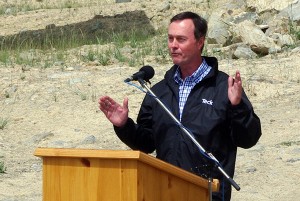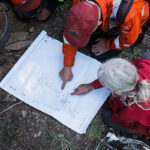Home »

Teck handed largest-ever Fisheries Act fine
Teck Coal was today handed two fines amounting to $60 million after pleading guilty in Provincial Court in Fernie to two charges of releasing selenium and calcite into the Elk and Fording rivers between January and December 2012.
Federal prosecutor Alexander Clarkson told court, “It’s the largest-ever penalty assessed under the Fisheries Act.”
Teck Resources Limited later announced in a media release that Teck Coal “has resolved charges under the Fisheries Act relating to 2012 discharges of selenium and calcite to a mine settling pond and to the Fording River from its Fording River and Greenhills steelmaking coal operations in the Elk Valley.
“The B.C. Provincial Court has accepted a plea of guilty and a joint sentencing submission by the Crown and Teck Coal in relation to two counts charging offences under s. 36(3) of the Fisheries Act. As part of the resolution Teck Coal will pay a penalty of $30 million in respect of each offence. The Crown will not proceed with charges relating to the same discharges over the period from 2013 to 2019.”

Don Lindsay, President and CEO Teck Resources Limited issued a statement addressing the decision.
“We sincerely apologize and take responsibility for the impacts of these discharges. Everyone at Teck is committed to responsible mining that protects the environment. Which is why, over the nine years since, we have worked hard to solve this challenge and ensure the watershed is sustained for the long term.
“Although there has been mining in the Elk Valley for more than 120 years, it was not until 2010-2012 – through independent research commissioned by Teck – that we began to understand the full extent of the impacts of selenium and calcite releases on water and aquatic health in the valley. We learned this was an extremely complex challenge connected to the long history of mining in the region, and that it required an extraordinary response. The Elk Valley is home to thousands of Teck employees and their families, and no one is more committed to solving this challenge than they are,” Lindsay stated.
“In 2013, under direction from the Government of B.C. and in consultation with the Ktunaxa Nation, scientists, and local communities, we developed the Elk Valley Water Quality Plan. The plan, approved by the B.C. Government in 2014, is a long-term strategy with the goal of stabilizing and reversing the trend of selenium, calcite and other constituents while improving the health of the watershed.”

Lindsay noted Teck has invested about $1 billion “so far to implement the plan and have constructed cutting-edge water treatment facilities that are successfully removing selenium and calcite from local waterways. We’ve undertaken a monitoring program that is tracking water quality and aquatic health in the Elk Valley and we are sharing the results with government, Indigenous Nations and the public. Further, we’ve implemented a major research and development program that is now conducting some of the most advanced mining-related environmental science anywhere in the world. The plan is adaptive, so as new and better technologies are developed, we will make them part of our approach.
“While there has been significant progress since 2012, much more remains to be done. Additional water treatment facilities are under construction now, with more in the planning stages. We plan to further invest up to $655 million over the next four years alone on work to protect the watershed, with even more to come in the years ahead.”
Lindsay added, “To our knowledge, a water quality plan of this size and complexity has never been done before anywhere in the world. It involves complicated science and world-leading environmental technology. It takes time and perseverance – there are no quick fixes. Along the way we have made progress and made mistakes, and we’ve learned from both, always striving to do better. We are committed to meeting this challenge and responsibly maintaining the billions in economic activity and over 15,000 jobs supported by our operations that are so critical to the Elk Valley and to B.C.”
His statement concluded with another apology.
“Again, to the Ktunaxa First Nation, whose territory we operate on, and to our communities in the Elk Valley, we deeply regret these impacts and we apologize. You have my commitment that we will not waver in our focus on addressing this challenge and working to ensure that the environment is protected for today and for future generations.”
Shortly after today’s court proceeding, the Ktunaxa Nation Council issued the following statement on the Fisheries Act charges against Teck Coal Limited.
“There have been significant impacts to wuʔu (the water) in Qukin ʔamaʔkis (Elk Valley) due to coal mining, and those impacts continue to grow today with Teck Coal Limited’s operations. It is essential that there is an appropriate and achievable plan in place to ensure that Teck Coal Limited meets water quality limits and addresses impacts to wuʔu and ʔa·kxamis ̓qapi qapsin (All Living Things). For many years the Ktunaxa Nation Council (KNC) has been actively engaged in government-to-government and government-to-industry work to hold accountable those responsible, and to contribute to addressing the considerable challenges we face with impacts to water quality. The value and significance of wuʔu to the Ktunaxa Nation and in Qukin ʔamaʔkis must not be understated. The Ktunaxa Nation Council will continue to be a voice for those who cannot speak for themselves – for the sake of wuʔu, our future generations, and for ʔa·kxamis ̓qapi qapsin. It is a critical part of our role and responsibility in Qukin ʔamaʔkis to the Creator.
“With respect to the recent Fisheries Act charges against Teck Coal Limited, the KNC provided a community impact statement to the court pursuant to section 722.2 of the Criminal Code. The statement identifies, in a general way, the harms and losses suffered by the Ktunaxa Nation from the deposition by Teck Coal Limited (“Teck”) of selenium and calcite pollution into fish-bearing waters within ʔamakʔis Ktunaxa (Ktunaxa Territory). The intent of the illustration (below) provided in the impact statement is to visually represent Ktunaxa “lifeways” within Qukin ʔamakʔis. This image is a product of Ktunaxa community participatory research drawn by two Ktunaxa artists – Darcy Luke and Marisa Phillips. It is meant to symbolize “Ktunaxa being Ktunaxa on the land” and the tangible and intangible connection between ʔamak ȼ wuʔu (the land and water), and ʔa’kxam̓is q̓api qapsin. This interconnectedness means nothing is in isolation; if wuʔu is impacted – so in turn is everything else.
“This case, the charges laid, and the fines assessed, are steps in acknowledging the harm that has been and continues to be done to ʔamak ȼ wuʔu (the land and water) by development impacts done without Ktunaxa consent,” The Ktunaxa Nation Council concluded.
Regional environmental watchdog Wildsight reported the court decision with a tweet, noting, “This is the largest fine ever under the federal Fisheries Act, by nearly 10 times. But more selenium and calcite pollution than ever is flowing today.”
 Image submitted by Ktunaxa Nation Council
Image submitted by Ktunaxa Nation Council
Lead image: Fording River Operations. e-KNOW file photo
e-KNOW







